The first of two eclipse seasons for the year is upon us this month, and kicks off with the only total solar eclipse for 2015 on Friday, March 20th.
And what a bizarre eclipse it is. Not only does this eclipse begin just 15 hours prior to the March equinox marking the beginning of astronomical spring in the northern hemisphere, but the shadow of totality also beats path through the high Arctic and ends over the North Pole.
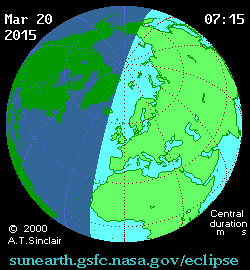
Already, umbraphiles — those who chase eclipses — are converging on the two small tracts of terra firma where the umbra of the Moon makes landfall: the Faroe and Svalbard islands. All of Europe, the northern swath of the African continent, north-central Asia and the Middle East will see a partial solar eclipse, and the eclipse will be deeper percentage-wise the farther north you are .
2015 features four eclipses in all: two total lunars and two solars, with one total solar and one partial solar eclipse. Four is the minimum number of eclipses that can occur in a calendar year, and although North America misses out on the solar eclipse action this time ’round, most of the continent gets a front row seat to the two final total lunar eclipses of the ongoing tetrad on April 4th and September 28th.
How rare is a total solar eclipse on the vernal equinox? Well, the last total solar eclipse on the March equinox occurred back in 1662 on March 20th. There was also a hybrid eclipse — an eclipse which was annular along a portion of the track, and total along another — on March 20th, 1681. But you won’t have to wait that long for the next, as another eclipse falls on the northward equinox on March 20th, 2034.
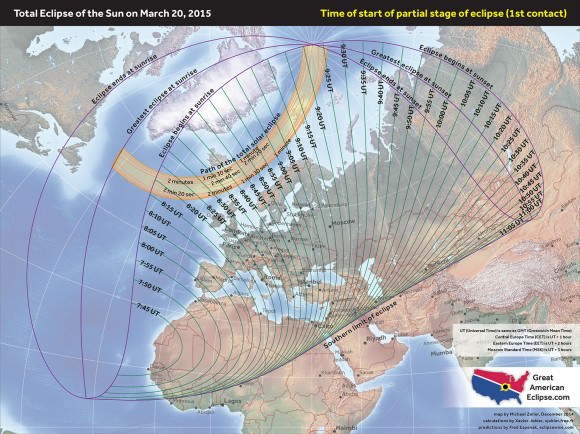
Note that in the 21st century, the March equinox falls on March 20th, and will start occasionally falling on March 19th in 2044. We’re also in that wacky time of year where North America has shifted back to ye ‘ole Daylight Saving (or Summer) Time, while Europe makes the change after the eclipse on March 29th. It really can wreak havoc with those cross-time zone plans, we know…
The March 20th eclipse also occurs only a day after lunar perigee, which falls on March 19th at 19:39 UT. This is also one of the closer lunar perigees for 2015 at 357,583 kilometres distant, though the maximum duration of totality for this eclipse is only 2 minutes and 47 seconds just northeast of the Faroe Islands.
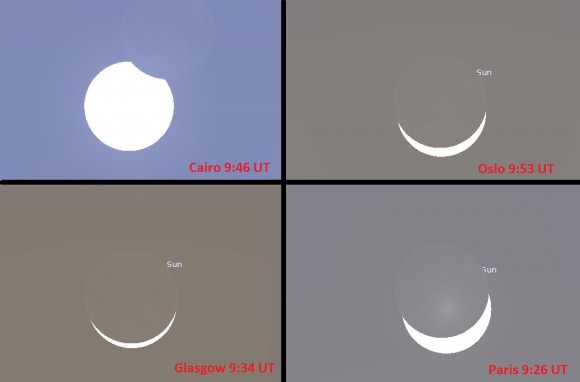
This eclipse is number 61 of 71 in solar saros series 120, which runs from 933 to 2754 AD. It’s also the second to last total in the series, with the final total solar eclipse for the saros cycle occurring one saros later on March 30th, 2033.
And speaking of obscure eclipse terminology, check out this neat compendium we came across in research. What’s an Exeligmos? How many Heptons are in a Gregoriana?
The 462 kilometre wide path of the eclipse touches down south of Greenland at 9:13 UT at sunrise, before racing across the North Atlantic towards the pole and departing the Earth at 10:21 UT. The sedate partial phases for the eclipse worldwide start at 7:40 UT, and run out to 11:51 UT.
What would it look like to sit at the North Pole and watch a total solar eclipse on the first day of Spring? It would be a remarkable sight, as the disk of the Sun skims just above the horizon for the first time since the September 2014 equinox. Does this eclipse occur at sunrise or sunset as seen from the pole? It would be a rare spectacle indeed!
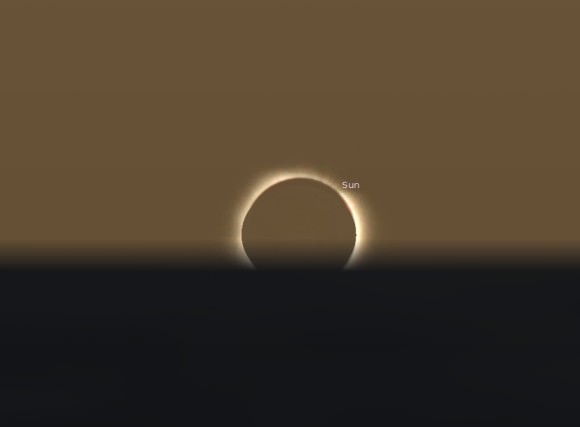
Alas, this unique view from the pole will more than likely go undocumented. A similar eclipse was caught in 2003 from the Antarctic, and a few intrepid eclipse chasers, including author David Levy did manage to make the journey down under to witness totality from the polar continent.
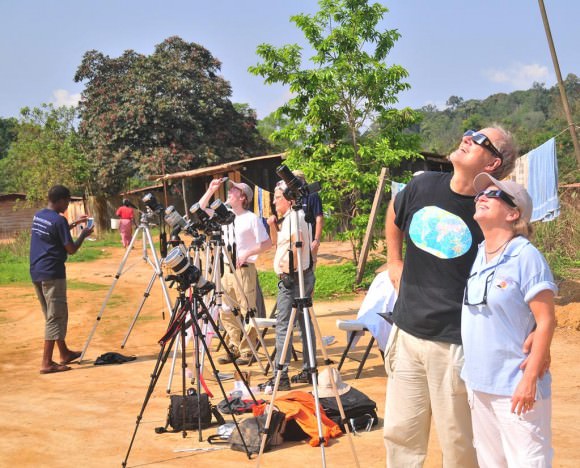
Safety is paramount when observing the Sun and a solar eclipse. Eye protection is mandatory during all partial phases across Europe, northern Asia, North Africa and the Middle East. A proper solar filter mask constructed of Baader safety film is easy to construct, and should fit snugly over the front aperture of a telescope. No. 14 welder’s goggles are also dense enough to look at the Sun, as are safety glasses specifically designed for eclipse viewing. Observing the Sun via projection or by using a pinhole projector is safe and easy to do.
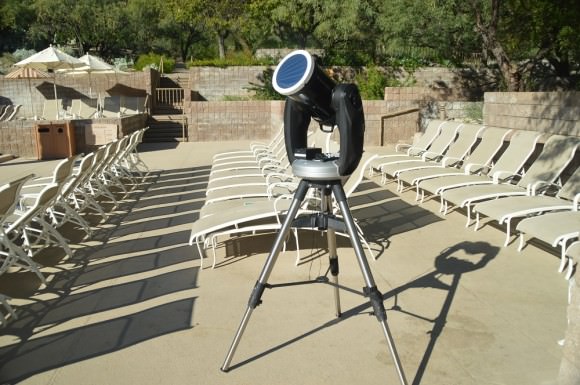
Weather is always the big variable in the days leading up to any eclipse. Unfortunately, March in the North Atlantic typically hosts stormy skies, and the low elevation of the eclipse in the sky may hamper observations as well. From the Faroe Islands, the Sun sits 18 degrees above the horizon during totality, while from the Svalbard Islands it’s even lower at 12 degrees in elevation. Much of Svalbard is also mountainous, making for sunless pockets of terrain that will be masked in shadow on eclipse day. Mean cloud amounts for both locales run in the 70% range, and the Eclipser website hosts a great in-depth climatology discussion for this and every eclipse.
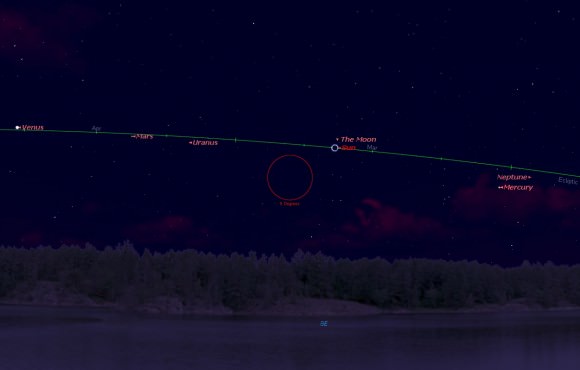
But don’t despair: you only need a clear view of the Sun to witness an eclipse!
Solar activity is also another big variable. Witnesses to the October 23rd, 2014 partial solar eclipse over the U.S. southwest will recall that we had a massive and very photogenic sunspot turned Earthward at the time. The Sun has been remarkably calm as of late, though active sunspot region 2297 is developing nicely. It will have rotated to the solar limb come eclipse day, and we should have a good grasp on what solar activity during the eclipse will look like come early next week.
And speaking of which: could an auroral display be in the cards for those brief few minutes of totality? It’s not out of the question, assuming the Sun cooperates. Of course, the pearly white corona of the Sun still gives off a considerable amount of light during totality, equal to about half the brightness of a Full Moon. Still, witnessing two of nature’s grandest spectacles — a total solar eclipse and the aurora borealis — simultaneously would be an unforgettable sight, and to our knowledge, has never been documented!
We also put together some simulations of the eclipse as seen from Earth and space:
Note that an area of southern Spain may witness a transit of the International Space Station during the partial phase of the eclipse. This projection is tentative, as the orbit of the ISS evolves over time. Be sure to check CALSky for accurate predictions in the days leading up to the eclipse.
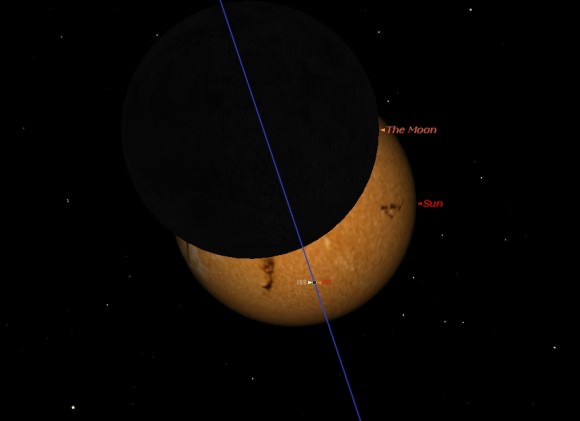
Can’t make it to the eclipse? Live in the wrong hemisphere? There are already a few planned webcasts for the March 20th eclipse:
–Astronomia Practica plans to post photos in near real time of the eclipse from northern Scotland.
-Slooh has plans to broadcast the eclipse from the Faroe Islands.
-And here’s another webcast from the Faroe Islands and the path of totality courtesy of Kringvarp Føroya:
-Here’s another broadcast planned of the partial stages of the eclipse as seen from the UK.
-And our friends over at the Virtual Telescope Project also plans on webcasting the solar eclipse:
… and speaking of which, there’s also an exciting new Kickstarter project entitled Chasing Shadows which is headed to the Arctic to follow veteran eclipse chaser Geoff Sims (@beyond_beneath of Twitter):
And stay tuned, as North America and the Pacific region will witness another total lunar eclipse on April 4th 2015. And we’ve only got one more total solar eclipse across Southeast Asia in 2016 before the total solar eclipse of August 21st 2017 spanning the U.S.
Let the first eclipse season of 2015 begin!
Next… how will the solar eclipse affect the European solar grid? Expect an article on just that soon!
- Be sure to send those eclipse pics in to Universe Today.
- Read Dave Dickinson’s tales of eclipse sci-fi, including Exeligmos, Shadowfall, and much more.

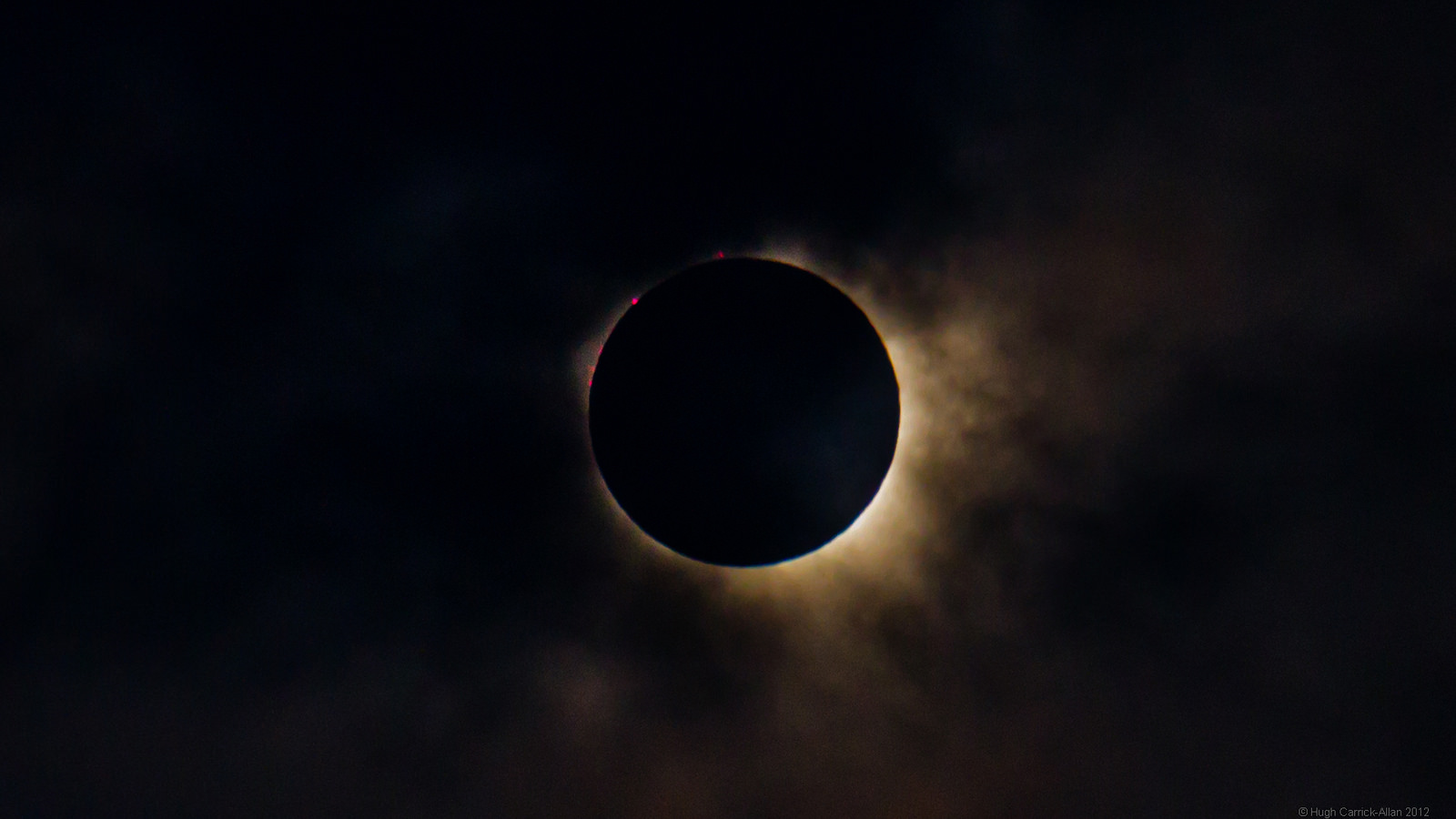
No fair. How come we don’t get to see it in the US? It’s a conspiracy. Seriously though, bucket list definitely includes an “umbraphile” journey one of these days. That and the aurora.
Just be around in 2017 and you can see one here in the U.S.
http://eclipse.gsfc.nasa.gov/SEmono/TSE2017/TSE2017.html
Great… we get to see a solar eclipse at night! That is to say.. this eclipse will make for an EXTRA dark night on the opposite side of Earth. How much darker? Hmm… got earth shine and atmospheric afterglow? Not? Well then.. maybe a rare moment for the dark side? ~@; )
I recently made a ‘mask’ for my new home made f3.4 12 1/2″ Newtonian. Last week’s full moon made me do that… I made a full aperture 1/2″w X 1/2″t plywood ring support as a front end support cover for my telescope. Then I super-glued thin black roofing paper to the ring. I cut 3X 3″ dia. concentric holes in the tarpaper. This mask VASTLY reduced secondary reflections and increased resolution and focus. Also… I kind of ‘re-invented’ a focusing mask? The 3X holes, when out of focus, are distinctly separated. Focusing brings them together at a single image/point.
Bottom line is that now I have a bright object AND focusing mask!
Bloon (Zero to Infinity, http://www.0ll00.com/), a spanish company launching balloons with plans to launch rockoons, satellites to orbit, humans to the edge, is crowd funding a balloon launch to view this eclipse.
This is a unique eclipse. Apparently, the next solar eclipse to pass over the north pole won’t happen again for another 500,000 years. I’d say we need to crowdfund this one.
https://www.indiegogo.com/projects/bloon-360view-of-a-total-solar-eclipse-from-space#home
Awesome coverage Dave as usual. Insane catalogue of eclipse cycles website.
I’ll second that. Excellent article.
Thanks! Will most likely be doing a post eclipse roundup of reader pics next Friday as well.
The total lunar eclipse of 4/4 seems to continue the “odd” designation, as totality lasts but 4 ½ minutes. Perhaps something in the water is causing these oddities. 😉